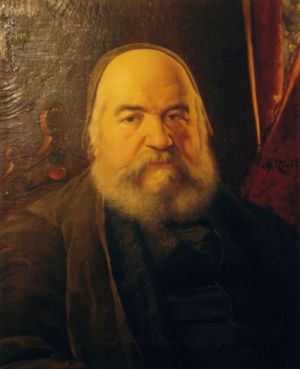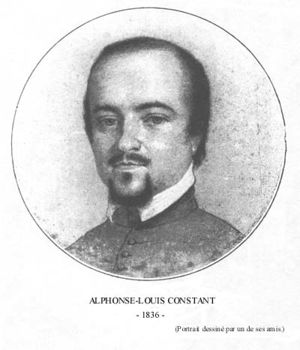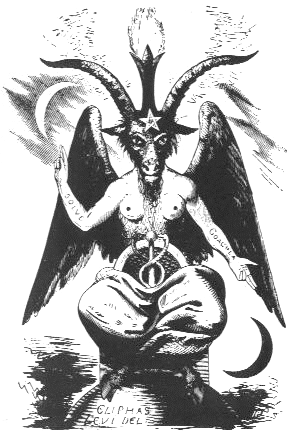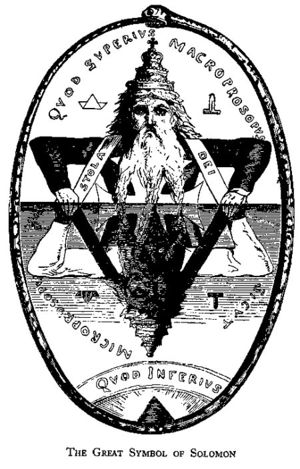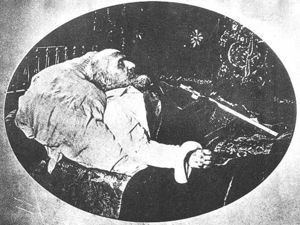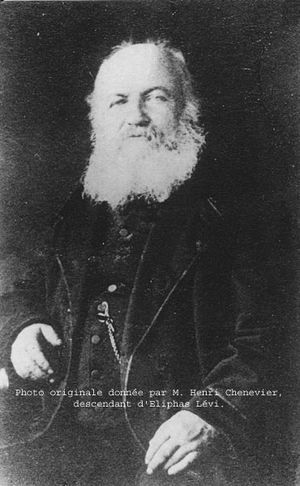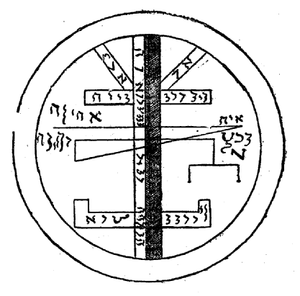Difference between revisions of "Éliphas Lévi"
(formatting fix) |
|||
| (25 intermediate revisions by 2 users not shown) | |||
| Line 1: | Line 1: | ||
| − | [[image:Eliphas_Levi_1874.jpg|Alphonse-Louis Constant, alias Éliphas Lévi in 1874|thumb]]'''Éliphas Lévi''', also '''Éliphas Lévi Zahed''' was the pseudonym | + | [[image:Eliphas_Levi_1874.jpg|Alphonse-Louis Constant, alias Éliphas Lévi in 1874|thumb]]'''Éliphas Lévi''', also '''Éliphas Lévi Zahed''' was the pseudonym used by the Catholic cleric '''Alphonse-Louis Constant''' (February 8, 1810, Paris - May 31, 1875, ibid.) to write and publish scripts of occult and magical contents from 1854 on. Lévi is said to have re-established occultism in the 19th century.<ref>l'Estoile, Arnaud de: ''Qui suis-je? Éliphas Lévi.'' Grez-sur-Loing: Pardès, 2008''.</ref> |
== Life == | == Life == | ||
=== Per aspera ... === | === Per aspera ... === | ||
| − | + | Constant's father was a shoemaker in Paris. Although the material conditions of his family were rather limited, Constant attended a school for the poor free of charge run by a parish and was able to attend a seminary. Ordained as a sub-deacon in 1835, he was entrusted with teaching assignments. Since he fell in love with one of his pupils (whom he thought to be a reincarnation of the Virgin Mary), he left the seminary prior to the ordination to priesthood. The relationship, however, failed shortly after this. | |
| − | [[image:Eliphas_Levi_1836.jpg|left|Portrait of the young man, 1836|thumb]] | + | [[image:Eliphas_Levi_1836.jpg|left|Portrait of the young man, 1836|thumb]]Disappointed with him leaving his education, Constant's mother committed suicide a few weeks later. Constant then saw a period of erratic quest. Within the following year, he made the acquaintance of Honoré de Balzac, befriended militant socialist [http://en.wikipedia.org/wiki/Flora_Tristan Flora Tristan], and yet still dreamt of a future as a priest. This dream took him to [http://en.wikipedia.org/wiki/St._Peter's_Abbey,_Solesmes St. Peter's Abbey], a Benedictine monastery in whose library of 20,000 volumes he became acquainted with scripts from early Christianity, by ancient gnostics, as well as the works of religious mystics. It was there he authored his first book "Le Rosier de Mai" which was as pious as it was romantic, but at the same time enthused about matters of love in such fancyful and vivid ways he was expelled from the monastery. |
| − | + | Since the archbishop of Paris, [http://en.wikipedia.org/wiki/Denis_Auguste_Affre Denis Auguste Affre], interceded on his behalf, Constant received an appointment as a supervisor at Juilly College east of Paris. Treated badly by his seniors, he wrote his first furious pamphlet, ''La Bible de la liberté''. Its publication in February 1841 not only caused a scandal within the church hierarchy, but also at the court in Versailles.<ref>A contemporary, if rather sardonic report of these incidents and of the following may be seen at: [http://catalogue.bnf.fr/ark:/12148/cb33497059p Mystères galans des théâtres de Paris]. Paris: Cazel, 1844. Page 88 et seqq.</ref> Constant was arrested and sentenced to a prison term of eight months and a fine of 300 Francs. Unable to raise this sum, he served eleven months in prison, studying the works of Swedish mystic Emmanuel Swedenborg. | |
| − | + | Following Constant's discharge, Bishop Affre recommended him to his colleague in Évreux<ref>[http://fr.wikipedia.org/wiki/Nicolas-Théodore_Olivier Nicolas-Théodore Olivier]</ref>, where, from February 1843, he preached so successfully that his fellow ministers jealously announced the death of abbé Constant in the newspapers. Despite a swift denial another scandal could not be avoided; the bishop, however, kept holding a protective hand over him, commissioning him with the realisation of a mural painting in a nunnery. Due to friends of his father's vouching for him, he almost was accepted as a member of the secretive [[Rosicrucianism|Rosicrucian Order]] and rumour has it he even had prospects of being made a Grand Master. However, this did not materialise, and the mural likewise never was finished, as in early 1844, Constant's rapport to the bishop rapidly deteriorated due to a further publication, ''La Mère de Dieu'', and Constant returned to Paris. | |
| − | Deeply | + | Deeply agitated by the death of his friend Flora Tristan, he published ''L'Émancipation de la femme ou le Testament de la paria'', followed by his pacifist manifesto ''La Fête-Dieu ou le Triomphe de la paix religieuse'' a year later (1845). He intensely studied the humanistic and the utopian ideas of the time, particularly [http://en.wikipedia.org/wiki/Saint-Simonianism Saint-Simonianism] and the theories of [http://en.wikipedia.org/wiki/Charles_fourier Charles Fourier]. But neither could convince him: Saint Simon taught religion without religiousness, which he found repulsive. And Fourier's approach of man's necessity for acting out his drives he considered absurd and foolish. |
| − | + | In the small town Choisy-le-Roi, located a few kilometres outside of Paris, he used to meet with a supervisor of a girls' school (presumably, see note). But while they were making plans to get married, her being pregnant from him, one of her friends fell in love with Constant, a minor by the name of [http://fr.wikipedia.org/wiki/Marie-Noémi_Cadiot Marie-Noémi Cadiot]. After some fiery love letters she escaped and hid in his attic. Faced with the choice between marrying her or being tried for seducing a minor, Constant married Cadiot on July 13, 1846. She gave birth to a daughter who died aged seven in 1854. Shortly after the death of their daughter, Cadiot left Constant.<ref>The events described in this paragraph ought to be taken cautiously, since most of what can be found on Constant in the internet seems to have been copied from the same source. As one example, all of them note a so-called "Institution Chandeau" in Choisy-le-Roi. However, even a lengthy research over several hours did not reveal any information on that institute, but identical wordings time and again, all of them apparently taken from the French Wikipedia (http://fr.wikipedia.org/wiki/Éliphas_Lévi). Chandeau is, as might be expected, a proper name, but nowhere mentioned with even a geographical connection to Choisy-le-Roi. Only one hint could be found: if "Institution Chandeau" is supposed to have been the name of a girls' school at the time in question, http://fr.topic-topos.com/ecole-emile-zola-choisy-le-roi might give at least a vague possibility for an explanation.</ref> | |
| − | The revolution of February 1848 brought more liberties for Alphonse | + | The revolution of February 1848 brought more liberties for Alphonse Constant, too. Just one year ago he had once more been convicted for one of his pamphlets, ''La Voix de la famine'', he was now able to freely act on the political stage. He was in charge of the left-wing magazine ''Le Tribun du peuple'' which faded away after the fourth issue, founded a political workers' association named (in revolutionary tradition) ''Le Club de la montagne''<ref>In the first National Assembly in 1791 the deputies of the political left were seated on the upper ranks, hence the name ''La montagne'' ("Mountain Party").</ref>, then in June, when the political reaction tried to turn back the wheel, he almost was shot by a firing squad. Another person was mistaken for him and executed in his place. Constant tried to be elected to the National Assemply, but a friend of his won the seat for which they competed, after which the long-term friendship broke up. |
| + | Financially, the Constant family was well off, since Marie-Noémie was now publishing literary feuilletons and received instructions from sculptor [http://en.wikipedia.org/wiki/James_Pradier James Pradier] who had already been promoted by the Roi Citoyen and now opened the doors to the society of Paris. In this connection, Constant received two government contracts for paintings for the Home Office. | ||
=== ... ad occultum === | === ... ad occultum === | ||
| − | + | [[image:Baphomet.png|Baphomet, drawing in '' Dogme et Rituel de la Haute Magie'', 1856|left|thumb]] | |
| − | + | Constant now began to turn to mysticism, theosophy, and [[occultism|occult]] knowledge in general. This had begun during his sojourn in Solesmes (1838-1839) and continued with his studies of Swedenborg as a convict in 1841, the contacts to the Rosicrucians (1843), and the studies of [http://en.wikipedia.org/wiki/Christian_Knorr_von_Rosenroth Rosenroth's] ''Kabbala denudata'' (1850/51). He took up using the name of Éliphas Lévi Zahed as a pseudonym, bestowed on him by the Rosicrucians and allegedly a translation of his name to Hebrew.<ref>This translation, however, is rather questionable, since the name Alphonse has Germanic roots, although its origin could not be fully established.</ref> During this time he also began authoring ''Dogme et rituel de la haute magie'' later on viewed his main work. | |
| + | In spring 1854, Lévi went to London where he made the acquaintance of then famous author [http://en.wikipedia.org/wiki/Edward_Bulwer-Lytton,_1st_Baron_Lytton Edward Bulwer-Lytton]. Their common interest in the occult soon made them friends.<ref>Having turned from social critic to occultist, Bulwer-Lytton's fictional work met the disposition for the magical and super-natural prevailant in his day, as well as the interest in archaeological discoveries. This he knew to wrap up in thrilling stories which made him an estimated author in the salons of the bourgeoisie, especially with a female audience. His late work ''The Coming Race'' still today inspires adherents of the theory of Nazi UFOs.</ref> Through Bulwer-Lytton's influence, he once more came into contact with Rosicrucian circles in which he succeeded in several alleged evocations, the most outstanding of which that of [http://de.wikipedia.org/wiki/Apollonios_von_Tyana Apollonios of Tyana]. During his times in London, Constant was also able to settle his private affairs in a favourable way: the young woman he had left in Choisy-le-Roi forgave him, and he accepted the illegitimate child as his. At the same time, the final separation from Marie-Noémi was realised with the help of a friend. | ||
| + | Back in Paris, Constant published the first volume of ''Dogme et rituel de la haute magie'' in 1854. In a number of essays, he documented his intensive studies of the Kabbala in a number of essays, all of which he published in the ''Revue philosophique et religieuse''. The periodical was founded in 1855 by Constant, Belgian writer [http://en.wikipedia.org/wiki/Camille_Lemonnier Camille Lemonnier] and French philosopher [http://fr.wikipedia.org/wiki/Charles_Fauvety Charles Fauvety], who managed the periodical during the three years of its existence. Constant additionally wrote several chansons, comparing Louis Napoléon Bonaparte, meanwhile emperor Napoléon III, to Caligula in one of them. This earned him another term in prison. | ||
| + | |||
| + | In 1859, at the age of 49 years, Constant saw an economical breakthrough: the publication of his ''History of Magic'' yielded some 1,000 Francs, the equivalent of more than 30,000 Euros in today's terms. ''L'Histoire de la magie'' was not only an economical success, but also gained him a wide recognition in the "esoteric" France, among them the physician [[Fernand Rozier]] who was to become a student of Lévi's. Eventually In March 1861, he was accepted into the Masonic Lodge ''La Rose du parfait silence'' and soon bestowed with the degree of a Master. A further book, ''La Clef des grands mystères'', appeared in the same year,the last part of the trilogy that starts with ''Histoire de la magie'' and of which ''Dogme et rituel de la haute magie'' was conceived the second part. [[file:levi_seal_solomon.jpg|Titel page of ''Le Grand Arcane'', edition of 1910|left|thumb]] | ||
| + | |||
| + | Lévi now did much work, mainly as teacher for the high aristocracy, and his teaching the Kabbalah to the new bishop of Évreux<ref>Supposed the date is correct that was [http://fr.wikipedia.org/wiki/Jean-Sébastien_Devoucoux Jean-Sébastien Devoucoux] who had headed the Évreux diocese since 1858. For a complete list of bishops see here: http://fr.wikipedia.org/wiki/Liste_des_évêques_d'Évreux</ref> speaks for his professional reputation. Financially he was well off and invested any surplus in his growing library. Lévi also started a correspondence with the Italian baronet Spedalieri, about whom nothing seems to have been passed on to us except that he became Lévi's most important patron and in reverse received a course on the Kabbalah in more than 1,000 letters. This exchange of letters lasted for almost thirteen years. | ||
| + | |||
| + | The years from 1861 were the most fruitful for his authorship. ''Le Sorcier de Meudon'' (1861) was followed by ''Fables et symboles'' a year later, containing extensive analyses of the symbolisms of Pythagoras, of the gospels, the talmud, and other sources. In 1865 he published ''Science des esprits'', and [http://en.wikipedia.org/wiki/Pierre_Larousse Pierre Larousse] asked him to contribute an essay on the Kabbalah for his ''Grand Dictionnaire''. At the same time he started working on a monograph on the [http://en.wikipedia.org/wiki/Zohar Zohar] which only got published after his death.<ref>http://gallica.bnf.fr/ark:/12148/bpt6k56839792/f107.image - This source claims that he also acted as the "head" of a society of "Grand Magicians" at this point in time. As a matter of fact the document is a belated apology of the Marian apparition at [http://en.wikipedia.org/wiki/Our_Lady_of_La_Salette La Salette] in 1846. Hence its objectiveness is rather dubious.</ref> | ||
| + | |||
| + | Then in 1870 The siege of Paris in 1870 happened to cut off Lévi from allowances from his students, and during his service | ||
| + | with the National Guard a heart disease manifested. In May 1861, with the episode of the Commune having ended, Lévi found himself at the end of all material resources once again. [[image:Eliphas_Levi_sul_letto_di_morte.jpg|Éliphas Lévi on his deathbed, 1875|thumb]] | ||
| + | |||
| + | Although still continuing with his work (in December 1871 he completed the ''Grimoire franco-latomorum'' on rites of the French freemasons), his physical condition deteriorated increasingly. In 1873, ''L'Évangile de la science'' was written, followed by his last work ''Catéchisme de la paix'' in January 1875. On May 31, 1875 Éliphas Lévi died at the age of 65. | ||
| + | |||
| + | == Reception == | ||
| + | [[image:Eliphas_Levi_1872_Photo_Originale.jpg|Portrait from 1872|left|thumb]] | ||
| + | In Second Empire Paris, Éliphas Lévi was a well known figure. His pursuit of esoteric matters, initially a rather casual interest, later provided him with a unique knowledge. By applying methods and forms of presentation of natural sciences to concepts of the supernatural, a connection between these two seemingly emerged, and the ''occult sciences'' took shape. | ||
| + | |||
| + | One reason for Éliphas Lévi's success may be seen in the fact that he was the first to follow this path consequently. He was the first after Heinrich Cornelius Agrippa von Nettesheim to study occultism more intensely than just fleetingly and thus was able to draw from substantial sources. Due to the wide range of subjects covered as well as because of their comparative originality, his works influenced all notable mystics in the afermath. His inclination for eccentric appearances, calculated for effect and regardless of possible negative outcome, contributed to further boosting his popularity. Seven years after his death,Paris newspaper ''Le Figaro'' published an editorial on him.<ref>[http://gallica.bnf.fr/ark:/12148/bpt6k278346v Un maitre sorcier. Le Figaro v. 6. Oktober 1882] (provides a detailed description of incidents connected to Lévi's near execution in 1848)</ref> | ||
| + | |||
| + | [[image:Talisman_universel_selon_levi.png|According to Papus, the universal charm discovered by Lévi banning all evil spirits, provided it was drawn on pristine parchment in golden ink and carried in a golden silk bag.|thumb]] | ||
| + | Apart from Fernand Rozier mentioned above, further mystics particularly influenced by Lévi were: | ||
| + | |||
| + | * Gérard Encausse (1865-1916), publishing as Papus, | ||
| + | * Stanislas de Guaita (1861-1897), | ||
| + | * Joséphin Péladan (1858-1918), calling himself Sâr Mérodack Joséphin Péladan. | ||
| + | Among the English-language mystics he reached were: | ||
| + | * [[Helena Blavatsky]] (1831-1891), | ||
| + | * H.P. Lovecraft (1890-1937), | ||
| + | * [[Aleister Crowley]] (1875-1947), considering himself a reincarnation of Lévi. | ||
| + | |||
| + | == Works == | ||
| + | Having chosen Éliphas Lévi for his pseudonym, he no longer published under his common name. A similarly clear distinction may be observed regarding with regards to content: works of theosophical/occult contents are authored exclusively by Éliphas Lévi, while the political pamphlets and the ''Dictionnaire de la littérature chrétienne'' was authored by Alphonse-Louis Constant. | ||
| + | |||
| + | === Alphonse-Louis Constant === | ||
| + | {|border="0" cellpadding="0" cellspacing="0" style="table-layout:fixed; padding:0px; background:rgb(255,255,255); margin:0px; margin-left:15px; margin-right:15px; width:100%; text-align:left; vertical-align:top; empty-cells:show;" | ||
| + | |- | ||
| + | |style="width:10%; vertical-align:top;"|1839 | ||
| + | |style="vertical-align:top;"|''Le Rosier de mai'' | ||
| + | |- | ||
| + | |1841 | ||
| + | |''La Bible de la liberté'' | ||
| + | |- | ||
| + | | | ||
| + | |''L'Assomption de la femme ou le Livre de l'amour'' | ||
| + | |- | ||
| + | | | ||
| + | |''Doctrines religieuses et sociales'' | ||
| + | |- | ||
| + | |1845 | ||
| + | |''La Fête-Dieu ou le Triomphe de la paix religieuse'' | ||
| + | |- | ||
| + | | | ||
| + | |''Paix! Paix! Réprimande adressée par un abbé et un théologien à Timon qui n'est ni l'un ni l'autre'' | ||
| + | |- | ||
| + | | | ||
| + | |''Le Livre des larmes ou le Christ consolateur, Essai de conciliation entre l'Église catholique et la philosophie moderne'' | ||
| + | |- | ||
| + | | | ||
| + | |''Les Trois Harmonies'' | ||
| + | |- | ||
| + | |1846 | ||
| + | |''La Dernière Incarnation'' | ||
| + | |- | ||
| + | | | ||
| + | |''La Voix de la famine'' | ||
| + | |- | ||
| + | |1847 | ||
| + | |''Le Deuil de la Pologne. Protestation de la Démocratie française et du Socialisme universel'' | ||
| + | |- | ||
| + | | | ||
| + | |''Rabelais à la Basmette'' | ||
| + | |- | ||
| + | | | ||
| + | |''Les Trois Malfaiteurs'' | ||
| + | |- | ||
| + | | | ||
| + | |''Le Sorcier de la Devinière'' | ||
| + | |- | ||
| + | |1848 | ||
| + | |Two Chansons: ''La Marseillaise du peuple'' und ''Le Règne du peuple'' | ||
| + | |- | ||
| + | | | ||
| + | |''Le Testament de la liberté'' | ||
| + | |- | ||
| + | |1851 | ||
| + | |''Dictionnaire de la littérature chrétienne'' | ||
| + | |- | ||
| + | |unknown | ||
| + | |''La Bible de l'humanité''<ref>found in: [http://gallica.bnf.fr/ark:/12148/bpt6k5600921q/f478.image Dictionnaire des pseudonymes], Paris, 1887. p. 461</ref> | ||
| + | |} | ||
| + | |||
| + | |||
| + | === Éliphas Lévi === | ||
| + | {|border="0" cellpadding="0" cellspacing="0" style="table-layout:fixed; padding:0px; background:rgb(255,255,255); margin:0px; margin-left:15px; margin-right:15px; width:100%; text-align:left; vertical-align:top; empty-cells:show;" | ||
| + | |- | ||
| + | |style="width:10%; vertical-align:top;"|1854 | ||
| + | |style="vertical-align:top;"|[http://gallica.bnf.fr/ark:/12148/bpt6k205564w ''Dogme et rituel de la haute magie, Tome 1: Dogme''] | ||
| + | |- | ||
| + | | | ||
| + | |''La Clavicule universelle des clavicules de Salomon ou le Grimoire des Grimoires'' (published posthumously) | ||
| + | |- | ||
| + | |1856 | ||
| + | |[http://gallica.bnf.fr/ark:/12148/bpt6k2055658 ''Dogme et rituel de la haute magie, Tome 2: Rituel''] | ||
| + | |- | ||
| + | |1856 et seq. | ||
| + | |''Carnet de notes'' (published posthumously) | ||
| + | |- | ||
| + | |1860 | ||
| + | |''La Clavicule prophétique des sept esprits de Jean Trithème'' (p.p.) | ||
| + | |- | ||
| + | |1861 | ||
| + | |''Histoire de la magie, avec une exposition claire de ses procédés, de ses rites et de ses mystères.'' Paris: Germer-Baillère, 1861<ref name="nouvdic">Information taken from: Manne, Edmond-Denis: [http://gallica.bnf.fr/ark:/12148/bpt6k2001347 Nouveau dictionnaire des ouvrages anonymes et pseudonymes]. Lyon: Scheuring, 1868</ref> | ||
| + | |- | ||
| + | | | ||
| + | |[http://gallica.bnf.fr/ark:/12148/bpt6k5510884x ''La clef des grands mystères suivant Hénoch, Abraham, Hermès Trismégiste et Salomon.''] Paris: Germer-Baillère, 1861. | ||
| + | |- | ||
| + | | | ||
| + | |[http://gallica.bnf.fr/ark:/12148/bpt6k82585p ''Le sorcier de Meudon.''] Paris: Librairie nouvelle, 1861 | ||
| + | |- | ||
| + | |1861 ff. | ||
| + | |''Cours de philosophie occulte. Lettres au baron Spedalieri'' (until Feb. 1874, p.p.) | ||
| + | |- | ||
| + | |1862 | ||
| + | |''La philosophie occulte. Fables et symboles, avec les explications.'' Paris: Germer-Baillère, 1862/ 63 (2 Bde.)<ref name="nouvdic" /> | ||
| + | |- | ||
| + | |1863 | ||
| + | |''Appel de la Pologne à la France par un Polonais'' | ||
| + | |- | ||
| + | |1864 | ||
| + | |''La science des esprits.'' Paris: Germer-Baillère, 1864<ref name="nouvdic" /> | ||
| + | |- | ||
| + | |1868/ 69 | ||
| + | |[http://gallica.bnf.fr/ark:/12148/bpt6k655196 ''Le Grand Arcane ou l'Occultisme dévoilé.''] Paris: Chamuel, 1898 (p.p.) | ||
| + | |- | ||
| + | |1869/ 70 | ||
| + | |[http://gallica.bnf.fr/ark:/12148/bpt6k54778959 ''Le livre des Sages.''] Paris: Bibliothèque Chacornac, 1912 (p.p) | ||
| + | |- | ||
| + | |1870 | ||
| + | |''Les Éléments de la Kabbale'' (p.p.) | ||
| + | |- | ||
| + | |1871 | ||
| + | |''Les Portes de l'avenir ou les Dernières Paroles d'un voyant'' (p.p.) | ||
| + | |- | ||
| + | | | ||
| + | |''Le Grimoire franco-latomorum'' (p.p.) | ||
| + | |- | ||
| + | |1872 - 74 | ||
| + | |''Le Voile du temple déchiré'' (p.p.) | ||
| + | |- | ||
| + | |1873 | ||
| + | |''L'Évangile de la science'' (p.p.) | ||
| + | |- | ||
| + | | | ||
| + | |''La Religion de la science'' (p.p.) | ||
| + | |- | ||
| + | | | ||
| + | |''Les Paradoxes de la haute science'' (p.p.) | ||
| + | |- | ||
| + | |1874 | ||
| + | |''La Sagesse des Anciens'' (p.p.) | ||
| + | |- | ||
| + | | | ||
| + | |''Le Livre d'Abraham le Juif retrouvé'' (p.p.) | ||
| + | |- | ||
| + | |1875 | ||
| + | |''Le Catéchisme de la paix'' (p.p.) | ||
| + | |- | ||
| + | |unknown | ||
| + | |''Clefs majeures et clavicules de Salomon.'' Paris, 1895<ref>Taken from: [http://gallica.bnf.fr/ark:/12148/bpt6k56761989/f16.image.r=Éliphas+Lévi.langEN Le Monde occulte Nr. 5-6]. Paris, 1903. Possibly erroneous, see 1854</ref> | ||
| + | |- | ||
| + | |unknown | ||
| + | |''Le Livre d'Hermès restitué et expliqué par Éliphas Lévi et commenté par Éliphas Ben Zahed'' | ||
| + | |- | ||
| + | |unknown | ||
| + | |''L'Annexe de Salomon'' | ||
| + | |} | ||
== References == | == References == | ||
<references /> | <references /> | ||
| + | |||
| + | {{OtherLang|ge=Éliphas Lévi|en=Éliphas Lévi}} | ||
| + | {{DEFAULTSORT:Levi, Eliphas}} | ||
| + | [[category:Occultist]] | ||
| + | [[category:Author]] | ||
Latest revision as of 10:53, 10 November 2014
Éliphas Lévi, also Éliphas Lévi Zahed was the pseudonym used by the Catholic cleric Alphonse-Louis Constant (February 8, 1810, Paris - May 31, 1875, ibid.) to write and publish scripts of occult and magical contents from 1854 on. Lévi is said to have re-established occultism in the 19th century.[1]
Life
Per aspera ...
Constant's father was a shoemaker in Paris. Although the material conditions of his family were rather limited, Constant attended a school for the poor free of charge run by a parish and was able to attend a seminary. Ordained as a sub-deacon in 1835, he was entrusted with teaching assignments. Since he fell in love with one of his pupils (whom he thought to be a reincarnation of the Virgin Mary), he left the seminary prior to the ordination to priesthood. The relationship, however, failed shortly after this.
Disappointed with him leaving his education, Constant's mother committed suicide a few weeks later. Constant then saw a period of erratic quest. Within the following year, he made the acquaintance of Honoré de Balzac, befriended militant socialist Flora Tristan, and yet still dreamt of a future as a priest. This dream took him to St. Peter's Abbey, a Benedictine monastery in whose library of 20,000 volumes he became acquainted with scripts from early Christianity, by ancient gnostics, as well as the works of religious mystics. It was there he authored his first book "Le Rosier de Mai" which was as pious as it was romantic, but at the same time enthused about matters of love in such fancyful and vivid ways he was expelled from the monastery.
Since the archbishop of Paris, Denis Auguste Affre, interceded on his behalf, Constant received an appointment as a supervisor at Juilly College east of Paris. Treated badly by his seniors, he wrote his first furious pamphlet, La Bible de la liberté. Its publication in February 1841 not only caused a scandal within the church hierarchy, but also at the court in Versailles.[2] Constant was arrested and sentenced to a prison term of eight months and a fine of 300 Francs. Unable to raise this sum, he served eleven months in prison, studying the works of Swedish mystic Emmanuel Swedenborg.
Following Constant's discharge, Bishop Affre recommended him to his colleague in Évreux[3], where, from February 1843, he preached so successfully that his fellow ministers jealously announced the death of abbé Constant in the newspapers. Despite a swift denial another scandal could not be avoided; the bishop, however, kept holding a protective hand over him, commissioning him with the realisation of a mural painting in a nunnery. Due to friends of his father's vouching for him, he almost was accepted as a member of the secretive Rosicrucian Order and rumour has it he even had prospects of being made a Grand Master. However, this did not materialise, and the mural likewise never was finished, as in early 1844, Constant's rapport to the bishop rapidly deteriorated due to a further publication, La Mère de Dieu, and Constant returned to Paris.
Deeply agitated by the death of his friend Flora Tristan, he published L'Émancipation de la femme ou le Testament de la paria, followed by his pacifist manifesto La Fête-Dieu ou le Triomphe de la paix religieuse a year later (1845). He intensely studied the humanistic and the utopian ideas of the time, particularly Saint-Simonianism and the theories of Charles Fourier. But neither could convince him: Saint Simon taught religion without religiousness, which he found repulsive. And Fourier's approach of man's necessity for acting out his drives he considered absurd and foolish.
In the small town Choisy-le-Roi, located a few kilometres outside of Paris, he used to meet with a supervisor of a girls' school (presumably, see note). But while they were making plans to get married, her being pregnant from him, one of her friends fell in love with Constant, a minor by the name of Marie-Noémi Cadiot. After some fiery love letters she escaped and hid in his attic. Faced with the choice between marrying her or being tried for seducing a minor, Constant married Cadiot on July 13, 1846. She gave birth to a daughter who died aged seven in 1854. Shortly after the death of their daughter, Cadiot left Constant.[4]
The revolution of February 1848 brought more liberties for Alphonse Constant, too. Just one year ago he had once more been convicted for one of his pamphlets, La Voix de la famine, he was now able to freely act on the political stage. He was in charge of the left-wing magazine Le Tribun du peuple which faded away after the fourth issue, founded a political workers' association named (in revolutionary tradition) Le Club de la montagne[5], then in June, when the political reaction tried to turn back the wheel, he almost was shot by a firing squad. Another person was mistaken for him and executed in his place. Constant tried to be elected to the National Assemply, but a friend of his won the seat for which they competed, after which the long-term friendship broke up.
Financially, the Constant family was well off, since Marie-Noémie was now publishing literary feuilletons and received instructions from sculptor James Pradier who had already been promoted by the Roi Citoyen and now opened the doors to the society of Paris. In this connection, Constant received two government contracts for paintings for the Home Office.
... ad occultum
Constant now began to turn to mysticism, theosophy, and occult knowledge in general. This had begun during his sojourn in Solesmes (1838-1839) and continued with his studies of Swedenborg as a convict in 1841, the contacts to the Rosicrucians (1843), and the studies of Rosenroth's Kabbala denudata (1850/51). He took up using the name of Éliphas Lévi Zahed as a pseudonym, bestowed on him by the Rosicrucians and allegedly a translation of his name to Hebrew.[6] During this time he also began authoring Dogme et rituel de la haute magie later on viewed his main work.
In spring 1854, Lévi went to London where he made the acquaintance of then famous author Edward Bulwer-Lytton. Their common interest in the occult soon made them friends.[7] Through Bulwer-Lytton's influence, he once more came into contact with Rosicrucian circles in which he succeeded in several alleged evocations, the most outstanding of which that of Apollonios of Tyana. During his times in London, Constant was also able to settle his private affairs in a favourable way: the young woman he had left in Choisy-le-Roi forgave him, and he accepted the illegitimate child as his. At the same time, the final separation from Marie-Noémi was realised with the help of a friend.
Back in Paris, Constant published the first volume of Dogme et rituel de la haute magie in 1854. In a number of essays, he documented his intensive studies of the Kabbala in a number of essays, all of which he published in the Revue philosophique et religieuse. The periodical was founded in 1855 by Constant, Belgian writer Camille Lemonnier and French philosopher Charles Fauvety, who managed the periodical during the three years of its existence. Constant additionally wrote several chansons, comparing Louis Napoléon Bonaparte, meanwhile emperor Napoléon III, to Caligula in one of them. This earned him another term in prison.
In 1859, at the age of 49 years, Constant saw an economical breakthrough: the publication of his History of Magic yielded some 1,000 Francs, the equivalent of more than 30,000 Euros in today's terms. L'Histoire de la magie was not only an economical success, but also gained him a wide recognition in the "esoteric" France, among them the physician Fernand Rozier who was to become a student of Lévi's. Eventually In March 1861, he was accepted into the Masonic Lodge La Rose du parfait silence and soon bestowed with the degree of a Master. A further book, La Clef des grands mystères, appeared in the same year,the last part of the trilogy that starts with Histoire de la magie and of which Dogme et rituel de la haute magie was conceived the second part.
Lévi now did much work, mainly as teacher for the high aristocracy, and his teaching the Kabbalah to the new bishop of Évreux[8] speaks for his professional reputation. Financially he was well off and invested any surplus in his growing library. Lévi also started a correspondence with the Italian baronet Spedalieri, about whom nothing seems to have been passed on to us except that he became Lévi's most important patron and in reverse received a course on the Kabbalah in more than 1,000 letters. This exchange of letters lasted for almost thirteen years.
The years from 1861 were the most fruitful for his authorship. Le Sorcier de Meudon (1861) was followed by Fables et symboles a year later, containing extensive analyses of the symbolisms of Pythagoras, of the gospels, the talmud, and other sources. In 1865 he published Science des esprits, and Pierre Larousse asked him to contribute an essay on the Kabbalah for his Grand Dictionnaire. At the same time he started working on a monograph on the Zohar which only got published after his death.[9]
Then in 1870 The siege of Paris in 1870 happened to cut off Lévi from allowances from his students, and during his service
with the National Guard a heart disease manifested. In May 1861, with the episode of the Commune having ended, Lévi found himself at the end of all material resources once again.
Although still continuing with his work (in December 1871 he completed the Grimoire franco-latomorum on rites of the French freemasons), his physical condition deteriorated increasingly. In 1873, L'Évangile de la science was written, followed by his last work Catéchisme de la paix in January 1875. On May 31, 1875 Éliphas Lévi died at the age of 65.
Reception
In Second Empire Paris, Éliphas Lévi was a well known figure. His pursuit of esoteric matters, initially a rather casual interest, later provided him with a unique knowledge. By applying methods and forms of presentation of natural sciences to concepts of the supernatural, a connection between these two seemingly emerged, and the occult sciences took shape.
One reason for Éliphas Lévi's success may be seen in the fact that he was the first to follow this path consequently. He was the first after Heinrich Cornelius Agrippa von Nettesheim to study occultism more intensely than just fleetingly and thus was able to draw from substantial sources. Due to the wide range of subjects covered as well as because of their comparative originality, his works influenced all notable mystics in the afermath. His inclination for eccentric appearances, calculated for effect and regardless of possible negative outcome, contributed to further boosting his popularity. Seven years after his death,Paris newspaper Le Figaro published an editorial on him.[10]
Apart from Fernand Rozier mentioned above, further mystics particularly influenced by Lévi were:
- Gérard Encausse (1865-1916), publishing as Papus,
- Stanislas de Guaita (1861-1897),
- Joséphin Péladan (1858-1918), calling himself Sâr Mérodack Joséphin Péladan.
Among the English-language mystics he reached were:
- Helena Blavatsky (1831-1891),
- H.P. Lovecraft (1890-1937),
- Aleister Crowley (1875-1947), considering himself a reincarnation of Lévi.
Works
Having chosen Éliphas Lévi for his pseudonym, he no longer published under his common name. A similarly clear distinction may be observed regarding with regards to content: works of theosophical/occult contents are authored exclusively by Éliphas Lévi, while the political pamphlets and the Dictionnaire de la littérature chrétienne was authored by Alphonse-Louis Constant.
Alphonse-Louis Constant
| 1839 | Le Rosier de mai |
| 1841 | La Bible de la liberté |
| L'Assomption de la femme ou le Livre de l'amour | |
| Doctrines religieuses et sociales | |
| 1845 | La Fête-Dieu ou le Triomphe de la paix religieuse |
| Paix! Paix! Réprimande adressée par un abbé et un théologien à Timon qui n'est ni l'un ni l'autre | |
| Le Livre des larmes ou le Christ consolateur, Essai de conciliation entre l'Église catholique et la philosophie moderne | |
| Les Trois Harmonies | |
| 1846 | La Dernière Incarnation |
| La Voix de la famine | |
| 1847 | Le Deuil de la Pologne. Protestation de la Démocratie française et du Socialisme universel |
| Rabelais à la Basmette | |
| Les Trois Malfaiteurs | |
| Le Sorcier de la Devinière | |
| 1848 | Two Chansons: La Marseillaise du peuple und Le Règne du peuple |
| Le Testament de la liberté | |
| 1851 | Dictionnaire de la littérature chrétienne |
| unknown | La Bible de l'humanité[11] |
Éliphas Lévi
| 1854 | Dogme et rituel de la haute magie, Tome 1: Dogme |
| La Clavicule universelle des clavicules de Salomon ou le Grimoire des Grimoires (published posthumously) | |
| 1856 | Dogme et rituel de la haute magie, Tome 2: Rituel |
| 1856 et seq. | Carnet de notes (published posthumously) |
| 1860 | La Clavicule prophétique des sept esprits de Jean Trithème (p.p.) |
| 1861 | Histoire de la magie, avec une exposition claire de ses procédés, de ses rites et de ses mystères. Paris: Germer-Baillère, 1861[12] |
| La clef des grands mystères suivant Hénoch, Abraham, Hermès Trismégiste et Salomon. Paris: Germer-Baillère, 1861. | |
| Le sorcier de Meudon. Paris: Librairie nouvelle, 1861 | |
| 1861 ff. | Cours de philosophie occulte. Lettres au baron Spedalieri (until Feb. 1874, p.p.) |
| 1862 | La philosophie occulte. Fables et symboles, avec les explications. Paris: Germer-Baillère, 1862/ 63 (2 Bde.)[12] |
| 1863 | Appel de la Pologne à la France par un Polonais |
| 1864 | La science des esprits. Paris: Germer-Baillère, 1864[12] |
| 1868/ 69 | Le Grand Arcane ou l'Occultisme dévoilé. Paris: Chamuel, 1898 (p.p.) |
| 1869/ 70 | Le livre des Sages. Paris: Bibliothèque Chacornac, 1912 (p.p) |
| 1870 | Les Éléments de la Kabbale (p.p.) |
| 1871 | Les Portes de l'avenir ou les Dernières Paroles d'un voyant (p.p.) |
| Le Grimoire franco-latomorum (p.p.) | |
| 1872 - 74 | Le Voile du temple déchiré (p.p.) |
| 1873 | L'Évangile de la science (p.p.) |
| La Religion de la science (p.p.) | |
| Les Paradoxes de la haute science (p.p.) | |
| 1874 | La Sagesse des Anciens (p.p.) |
| Le Livre d'Abraham le Juif retrouvé (p.p.) | |
| 1875 | Le Catéchisme de la paix (p.p.) |
| unknown | Clefs majeures et clavicules de Salomon. Paris, 1895[13] |
| unknown | Le Livre d'Hermès restitué et expliqué par Éliphas Lévi et commenté par Éliphas Ben Zahed |
| unknown | L'Annexe de Salomon |
References
- ↑ l'Estoile, Arnaud de: Qui suis-je? Éliphas Lévi. Grez-sur-Loing: Pardès, 2008.
- ↑ A contemporary, if rather sardonic report of these incidents and of the following may be seen at: Mystères galans des théâtres de Paris. Paris: Cazel, 1844. Page 88 et seqq.
- ↑ Nicolas-Théodore Olivier
- ↑ The events described in this paragraph ought to be taken cautiously, since most of what can be found on Constant in the internet seems to have been copied from the same source. As one example, all of them note a so-called "Institution Chandeau" in Choisy-le-Roi. However, even a lengthy research over several hours did not reveal any information on that institute, but identical wordings time and again, all of them apparently taken from the French Wikipedia (http://fr.wikipedia.org/wiki/Éliphas_Lévi). Chandeau is, as might be expected, a proper name, but nowhere mentioned with even a geographical connection to Choisy-le-Roi. Only one hint could be found: if "Institution Chandeau" is supposed to have been the name of a girls' school at the time in question, http://fr.topic-topos.com/ecole-emile-zola-choisy-le-roi might give at least a vague possibility for an explanation.
- ↑ In the first National Assembly in 1791 the deputies of the political left were seated on the upper ranks, hence the name La montagne ("Mountain Party").
- ↑ This translation, however, is rather questionable, since the name Alphonse has Germanic roots, although its origin could not be fully established.
- ↑ Having turned from social critic to occultist, Bulwer-Lytton's fictional work met the disposition for the magical and super-natural prevailant in his day, as well as the interest in archaeological discoveries. This he knew to wrap up in thrilling stories which made him an estimated author in the salons of the bourgeoisie, especially with a female audience. His late work The Coming Race still today inspires adherents of the theory of Nazi UFOs.
- ↑ Supposed the date is correct that was Jean-Sébastien Devoucoux who had headed the Évreux diocese since 1858. For a complete list of bishops see here: http://fr.wikipedia.org/wiki/Liste_des_évêques_d'Évreux
- ↑ http://gallica.bnf.fr/ark:/12148/bpt6k56839792/f107.image - This source claims that he also acted as the "head" of a society of "Grand Magicians" at this point in time. As a matter of fact the document is a belated apology of the Marian apparition at La Salette in 1846. Hence its objectiveness is rather dubious.
- ↑ Un maitre sorcier. Le Figaro v. 6. Oktober 1882 (provides a detailed description of incidents connected to Lévi's near execution in 1848)
- ↑ found in: Dictionnaire des pseudonymes, Paris, 1887. p. 461
- ↑ 12.0 12.1 12.2 Information taken from: Manne, Edmond-Denis: Nouveau dictionnaire des ouvrages anonymes et pseudonymes. Lyon: Scheuring, 1868
- ↑ Taken from: Le Monde occulte Nr. 5-6. Paris, 1903. Possibly erroneous, see 1854
Versions of this article in other languages
- Deutsch: Éliphas Lévi
